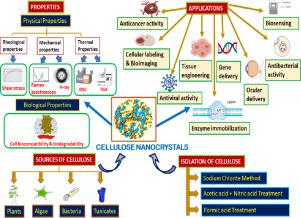Carbohydrate Polymers ( IF 10.7 ) Pub Date : 2021-09-14 , DOI: 10.1016/j.carbpol.2021.118668 Prajakta Mali 1 , Atul P Sherje 1

|
The present review explores the recent developments of cellulose nanocrystals, a class of captivating nanomaterials in variety of applications. CNCs are made by acid hydrolysing cellulosic materials like wood, cotton, tunicate, flax fibers by sonochemistry. It has many desirable properties, including a high tensile strength, wide surface area, stiffness, exceptional colloidal stability, and the ability to be modified. CNCs are colloidally stable, hydrophilic, and rigid rod-shaped bio-based nanomaterials in the form of rigid rods with high strength and surface area that has a diverse set of applications and properties. The intriguing features emerging from numerous fibers studies, such as renewable character and biodegradability, piqued the curiosity of many researchers who worked on lowering the size of these fibers. Physicochemical properties such as rheological, mechanical, thermal, lipid crystalline, swelling capacity, microstructural properties result in affecting surface-area to volume ratio and crystallinity of cellulose nanocrystals. The present article highlights the fundamentals of cellulose nanocrystals such as sources, isolation, fabrication, properties and surface modification with an emphasis on plethora of biomedical applications. Selected nanocellulose studies with significant findings on cellular labelling and bioimaging, tissue engineering, biosensors, gene delivery, anti-viral property, anti-bacterial property, ocular delivery, modified drug release, anti-cancer activity and enzyme immobilization are emphasized.
中文翻译:

纤维素纳米晶体:基础和生物医学应用
本综述探讨了纤维素纳米晶体的最新发展,这是一类在各种应用中引人入胜的纳米材料。CNC 是通过声化学酸水解纤维素材料(如木材、棉花、被囊动物、亚麻纤维)制成的。它具有许多理想的特性,包括高拉伸强度、宽表面积、刚度、出色的胶体稳定性和改性能力。CNCs 是胶体稳定、亲水和刚性棒状生物基纳米材料,呈刚性棒状,具有高强度和表面积,具有多种应用和特性。许多纤维研究中出现的有趣特征,例如可再生特性和生物降解性,激起了许多致力于降低这些纤维尺寸的研究人员的好奇心。物理化学性质如流变学、机械学、热学、脂质结晶、溶胀能力、微观结构性质导致影响纤维素纳米晶体的表面积与体积比和结晶度。本文重点介绍了纤维素纳米晶体的基本原理,例如来源、分离、制造、性质和表面改性,重点是过多的生物医学应用。重点介绍了在细胞标记和生物成像、组织工程、生物传感器、基因传递、抗病毒特性、抗菌特性、眼部传递、改良药物释放、抗癌活性和酶固定方面取得重大发现的纳米纤维素研究。微观结构特性会影响纤维素纳米晶体的表面积与体积比和结晶度。本文重点介绍了纤维素纳米晶体的基本原理,例如来源、分离、制造、性质和表面改性,重点是过多的生物医学应用。重点介绍了在细胞标记和生物成像、组织工程、生物传感器、基因传递、抗病毒特性、抗菌特性、眼部传递、修饰药物释放、抗癌活性和酶固定方面取得重大发现的纳米纤维素研究。微观结构特性会影响纤维素纳米晶体的表面积与体积比和结晶度。本文重点介绍了纤维素纳米晶体的基本原理,例如来源、分离、制造、性质和表面改性,重点是过多的生物医学应用。重点介绍了在细胞标记和生物成像、组织工程、生物传感器、基因传递、抗病毒特性、抗菌特性、眼部传递、修饰药物释放、抗癌活性和酶固定方面取得重大发现的纳米纤维素研究。特性和表面改性,重点是过多的生物医学应用。重点介绍了在细胞标记和生物成像、组织工程、生物传感器、基因传递、抗病毒特性、抗菌特性、眼部传递、修饰药物释放、抗癌活性和酶固定方面取得重大发现的纳米纤维素研究。特性和表面改性,重点是过多的生物医学应用。重点介绍了在细胞标记和生物成像、组织工程、生物传感器、基因传递、抗病毒特性、抗菌特性、眼部传递、修饰药物释放、抗癌活性和酶固定方面取得重大发现的纳米纤维素研究。











































 京公网安备 11010802027423号
京公网安备 11010802027423号